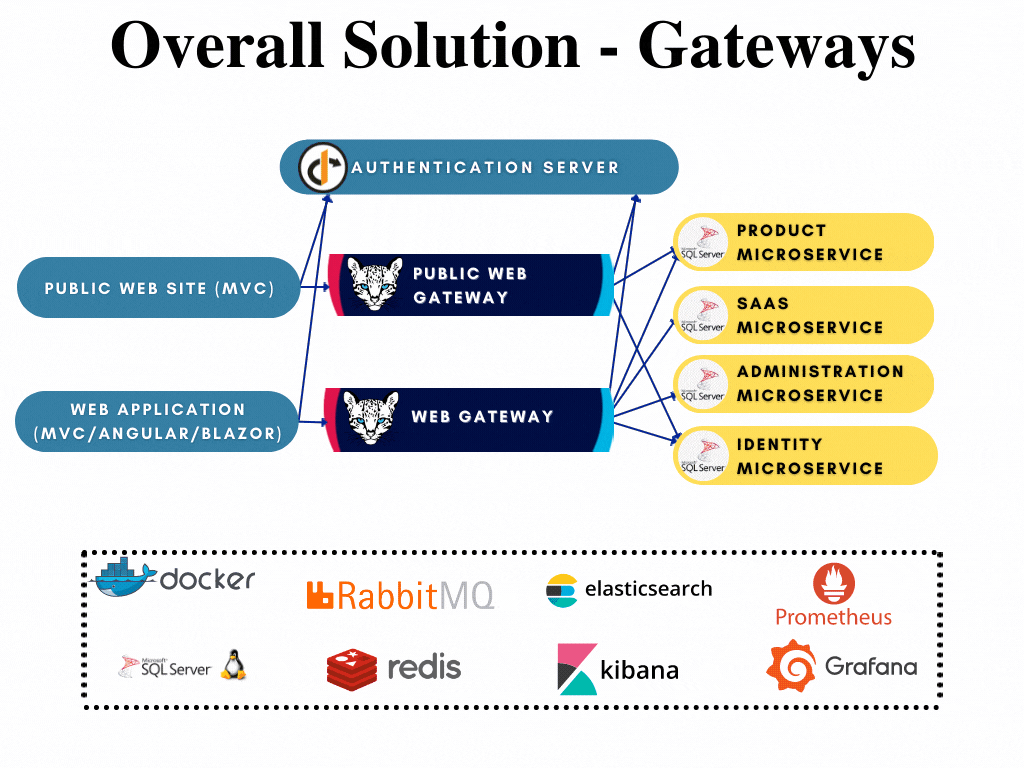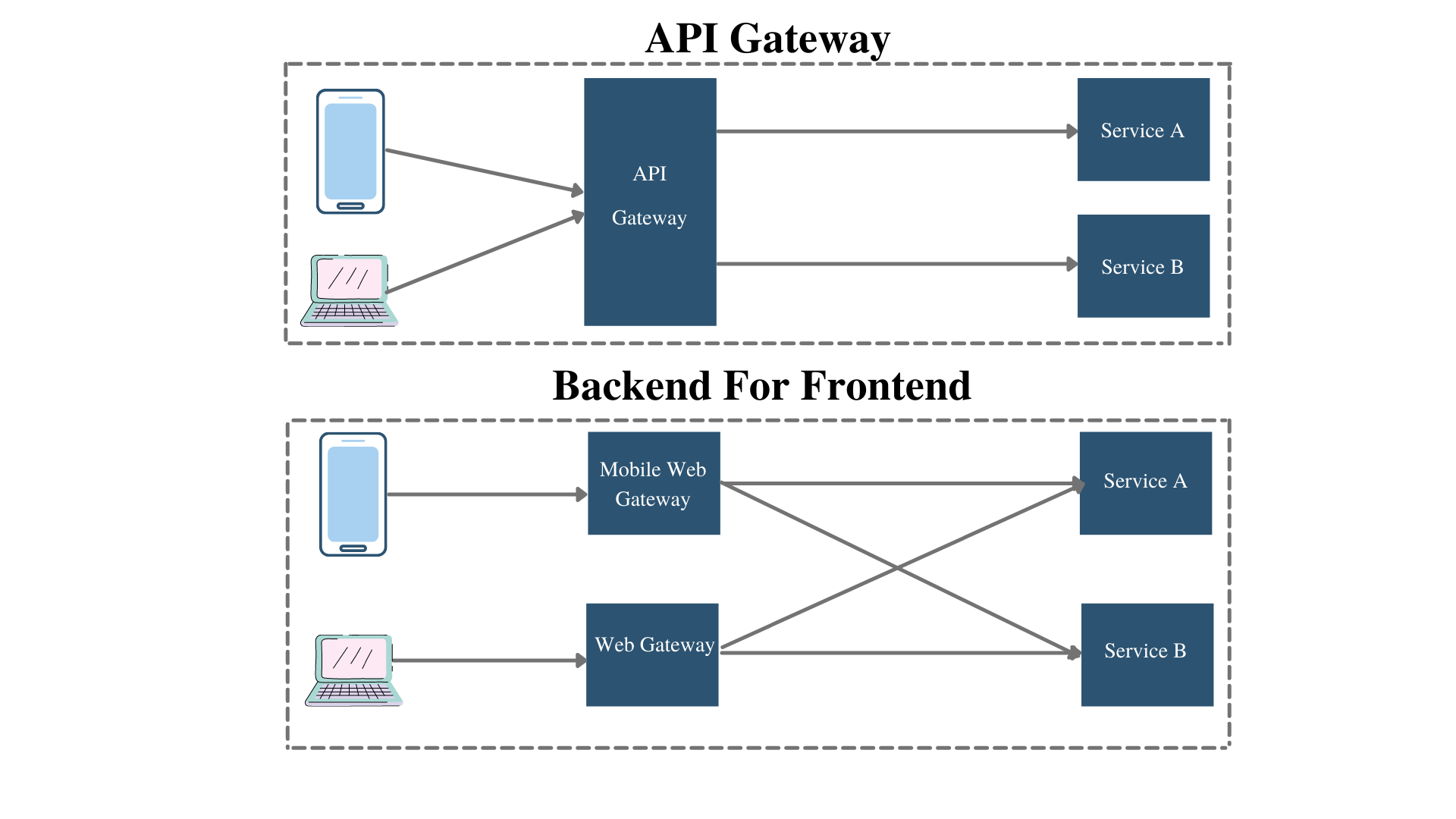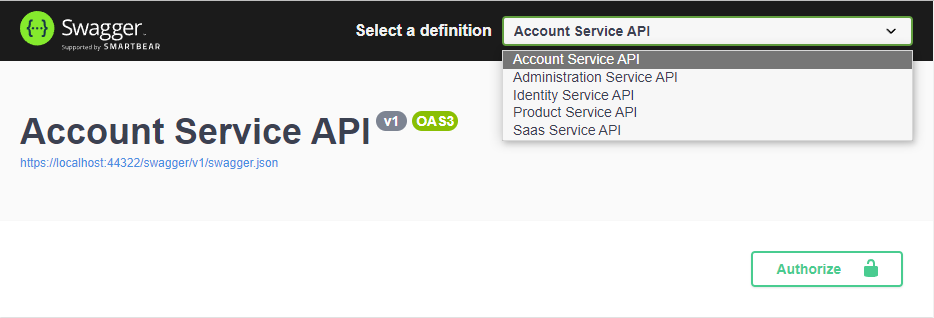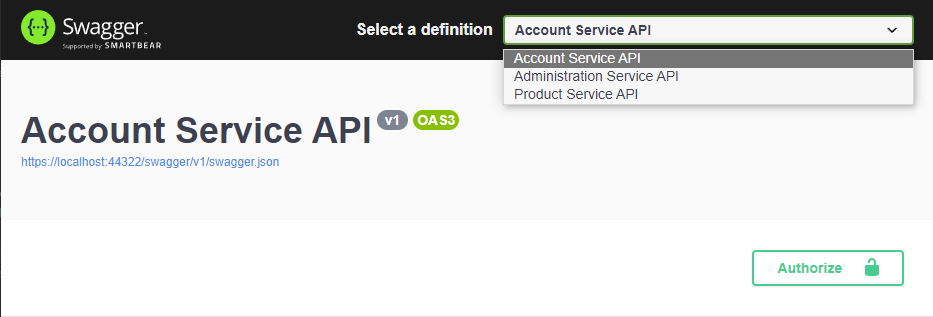Microservice Startup Template: API Gateways
API Gateways are used as single entry point to the microservices. ABP microservice startup template uses Ocelot .Net Api Gateway library. Through this library, gateways have the functionality of routing; rate limiting, retry policies etc. For more, check out Ocelot Documentations.
There are 2 different gateways are presented in the microservice startup template;
- Web Gateway is located under gateways/web folder. This API Gateway uses BFF pattern and redirects requests from Web application (MVC/Agular/Blazor) to Authentication Server or microservices.
- Public Web Gateway is located under gateways/webpublic folder. This API Gateway also uses BFF pattern and redirects requests from Public Web application to Authentication Server or microservices.
All gateways has their respected solutions created already and can be developed further when if required without opening the whole template solution. The following image shows the gateway highlighted in the overall solution diagram:

To compare microservice template to tiered application template: Gateway is an API.Host project that proxies all the requests to related microservices.
All gateways depends on SharedHostingGatewayModule which implements default Ocelot and Polly configurations (see the Shared Modules section).
Backend for Frontend Pattern (BFF)
While API Gateway provides a single point of entry to system, Backend for Frontend pattern defines each client with an individual API. The Microservice solution template uses BFF pattern thus each application has its own web gateway.

If you are planning to add your custom client (such as mobile application), it is recommended to add a new gateway for that specific client since each client's requests will probably be different.
Web Gateway
Web Gateway is used to connect the Web (back-office) application to microservices. This is done by setting this gateway as default RemoteService in Web application appsettings.
Module Configuration and Routing
As default, this gateway proxies each request from back-office application to related microservice and redirects the account related requests to AuthServer. Ocelot re-route configuration can be found in ocelot.json file. This configuration is added by using AddOcelotJson extension method in Program.cs. The re-routing configuration is as below:
Identity Service: Uses static proxy and re-routes
/api/identity/{everything}/api/identity-server/{everything}/api/account-admin/{everything}
to
localhost:44388(IdentityService).Administration Service: Uses static proxy and re-routes
/api/abp/{everything}application configuration endpoint/api/audit-logging/{everything}/api/language-management/{everything}/api/text-template-management/{everything}/api/feature-management/{everything}/api/permission-management/{everything}/api/setting-management/{everything}/api/lepton-theme-management/{everything}
to
localhost:44367(AdministrationService).Saas Service: Uses static proxy and re-routes
/api/saas/{everything}
to
localhost:44381(SaasService).Product Service: Uses static proxy and re-routes
/api/product-service/{everything}
to
localhost:44361(ProductService).Account Service: Uses static proxy and re-routes
/api/account/{everything}(login page etc requests)
to
localhost:44322(AuthServer).
Swagger and Authorization Configuration
Web Gateway has swagger with authorization configuration to make authorization_code interaction with AuthServer to be able to get authorized scopes:
SwaggerConfigurationHelper.ConfigureWithAuth(
context: context,
authority: configuration["AuthServer:Authority"],
scopes: new
Dictionary<string, string> /* Requested scopes for authorization code request and descriptions for swagger UI only */ {
{ "AccountService", "Account Service API" },
{ "IdentityService", "Identity Service API" },
{ "AdministrationService", "Administration Service API" },
{ "SaasService", "Saas Service API" },
{ "ProductService", "Product Service API" }
},
apiTitle: "Web Gateway API"
);
As default, Web Gateway makes requests to all api scopes that are already allowed when the WebGateway_Swagger client is being created in IdentityServer configuration. To be able to make the request, required information is found under AuthServer section in appsettings.json:
"AuthServer": {
"Authority": "https://localhost:44322",
"RequireHttpsMetadata": "true",
"SwaggerClientId": "WebGateway_Swagger",
"SwaggerClientSecret": "1q2w3e*"
},
Each routed service is added to swagger definitions distinctively that uses the same SwaggerClientId and SwaggerClientSecret from appsettings.
app.UseSwaggerUI(options =>
{
var configuration = context.ServiceProvider.GetRequiredService<IConfiguration>();
var routes = configuration.GetSection("Routes").Get<List<OcelotConfiguration>>();
var routedServices = routes
.GroupBy(t => t.ServiceKey)
.Select(r => r.First())
.Distinct();
foreach (var config in routedServices.OrderBy(q => q.ServiceKey))
{
var url = $"{config.DownstreamScheme}://{config.DownstreamHostAndPorts.FirstOrDefault()?.Host}:{config.DownstreamHostAndPorts.FirstOrDefault()?.Port}";
if (!env.IsDevelopment())
{
url = $"https://{config.DownstreamHostAndPorts.FirstOrDefault()?.Host}";
}
options.SwaggerEndpoint($"{url}/swagger/v1/swagger.json", $"{config.ServiceKey} API");
options.OAuthClientId(configuration["AuthServer:SwaggerClientId"]);
options.OAuthClientSecret(configuration["AuthServer:SwaggerClientSecret"]);
}
});
This will allow each re-routed microservice to be selected from definition and authorized individually by using the same WebGateway_Swagger client.

If you add a new microservice and want to use in your Web application; you need to [update this gateway configuration](/docs/commercial/5.3/startup-templates/microservice/add-microservice#updating gateways) and IdentityServer configuration.
Public Web Gateway
Public Web Gateway is used to connect the Public Web (landing page) application to microservices. This is done by setting this gateway as default RemoteService in Public Web application appsettings. (See here)
Module Configuration and Routing
As default, this gateway proxies each request landing page application to related microservice and redirects the account related requests to AuthServer. Ocelot re-route configuration can be found in ocelot.json file. This configuration is added by using AddOcelotJson extension method in Program.cs. The re-routing configuration is as below:
Account Service: Uses static proxy and re-routes
/api/account/{everything}(login page etc requests)
to
localhost:44322(Authentication Server).Administration Service: Uses static proxy and re-routes
/api/abp/{everything}application configuration endpoint
to
localhost:44367(AdministrationService).Product Service: Uses static proxy and re-routes
/api/product-service/{everything}
to
localhost:44361(ProductService).
Authorization Configuration
Public Web Gateway has swagger with authorization configuration to make authorization_code interaction with AuthServer to be able to get authorized scopes:
SwaggerConfigurationHelper.ConfigureWithAuth(
context: context,
authority: configuration["AuthServer:Authority"],
scopes: new Dictionary<string, string> /* Requested scopes for authorization code request and descriptions for swagger UI only */ {
{ "AccountService", "Account Service API" },
{ "AdministrationService", "Administration Service API" },
{ "ProductService", "Product Service API" }
},
apiTitle: "Public Web Gateway API"
);
As default, PublicWeb Gateway makes requests to only ProductService scope that is already allowed when the PublicWebGateway_Swagger client is being created in IdentityServer configuration. To be able to make the request, required information is found under AuthServer section in appsettings.json:
"AuthServer": {
"Authority": "https://localhost:44322",
"RequireHttpsMetadata": "true",
"SwaggerClientId": "WebGateway_Swagger",
"SwaggerClientSecret": "1q2w3e*"
},
Each routed service is added to swagger definitions distinctively that uses the same SwaggerClientId and SwaggerClientSecret from appsettings.
app.UseSwaggerUI(options =>
{
var configuration = context.ServiceProvider.GetRequiredService<IConfiguration>();
var routes = configuration.GetSection("Routes").Get<List<OcelotConfiguration>>();
var routedServices = routes
.GroupBy(t => t.ServiceKey)
.Select(r => r.First())
.Distinct();
foreach (var config in routedServices.OrderBy(q => q.ServiceKey))
{
var url = $"{config.DownstreamScheme}://{config.DownstreamHostAndPorts.FirstOrDefault()?.Host}:{config.DownstreamHostAndPorts.FirstOrDefault()?.Port}";
if (!env.IsDevelopment())
{
url = $"https://{config.DownstreamHostAndPorts.FirstOrDefault()?.Host}";
}
options.SwaggerEndpoint($"{url}/swagger/v1/swagger.json", $"{config.ServiceKey} API");
options.OAuthClientId(configuration["AuthServer:SwaggerClientId"]);
options.OAuthClientSecret(configuration["AuthServer:SwaggerClientSecret"]);
}
});
This will allow each re-routed microservice to be selected from definition and authorized individually by using the same WebGateway_Swagger client.

If you add a new microservice and want to use in your PublicWeb application; you need to update this gateway configuration and IdentityServer configuration.


























































